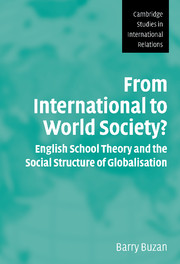 From International to World Society?
From International to World Society? Published online by Cambridge University Press: 14 January 2010
The survey in chapter 3 exposed four underlying conceptual dyads on which much of the discussion (and the confusion) about international and world society hang:
state and non-state levels, and whether or not the distinction between them is what defines the difference between international and world society;
physical (or mechanical) and social concepts of system, and whether the distinction along these lines between ‘international system’ and ‘international society’ should be retained, and/or carried over into one between ‘world system’ and ‘world society’;
society and community, and whether or not these two conceptions of social relations need to play a larger role in thinking about both international and world society, and what the implications of their doing so are for understanding pluralism and solidarism;
individuals and transnational actors as the units of analysis that define world society, and whether or not they can comfortably be considered together, or whether more analytical leverage is acquired by keeping them distinct.
The choices posed by these dyads need to be made explicit, and to be resolved in some way, before any clear sense can be made of English school theory as a social structural project. For the reasons given above, my starting position will be to reject the inclinations of the Vincentians and many of the non-English school users of world society, to construct world society in holistic terms that combine the state and non-state into a kind of higher, or better developed, social form.
To save this book to your Kindle, first ensure [email protected] is added to your Approved Personal Document E-mail List under your Personal Document Settings on the Manage Your Content and Devices page of your Amazon account. Then enter the ‘name’ part of your Kindle email address below. Find out more about saving to your Kindle.
Note you can select to save to either the @free.kindle.com or @kindle.com variations. ‘@free.kindle.com’ emails are free but can only be saved to your device when it is connected to wi-fi. ‘@kindle.com’ emails can be delivered even when you are not connected to wi-fi, but note that service fees apply.
Find out more about the Kindle Personal Document Service.
To save content items to your account, please confirm that you agree to abide by our usage policies. If this is the first time you use this feature, you will be asked to authorise Cambridge Core to connect with your account. Find out more about saving content to Dropbox.
To save content items to your account, please confirm that you agree to abide by our usage policies. If this is the first time you use this feature, you will be asked to authorise Cambridge Core to connect with your account. Find out more about saving content to Google Drive.